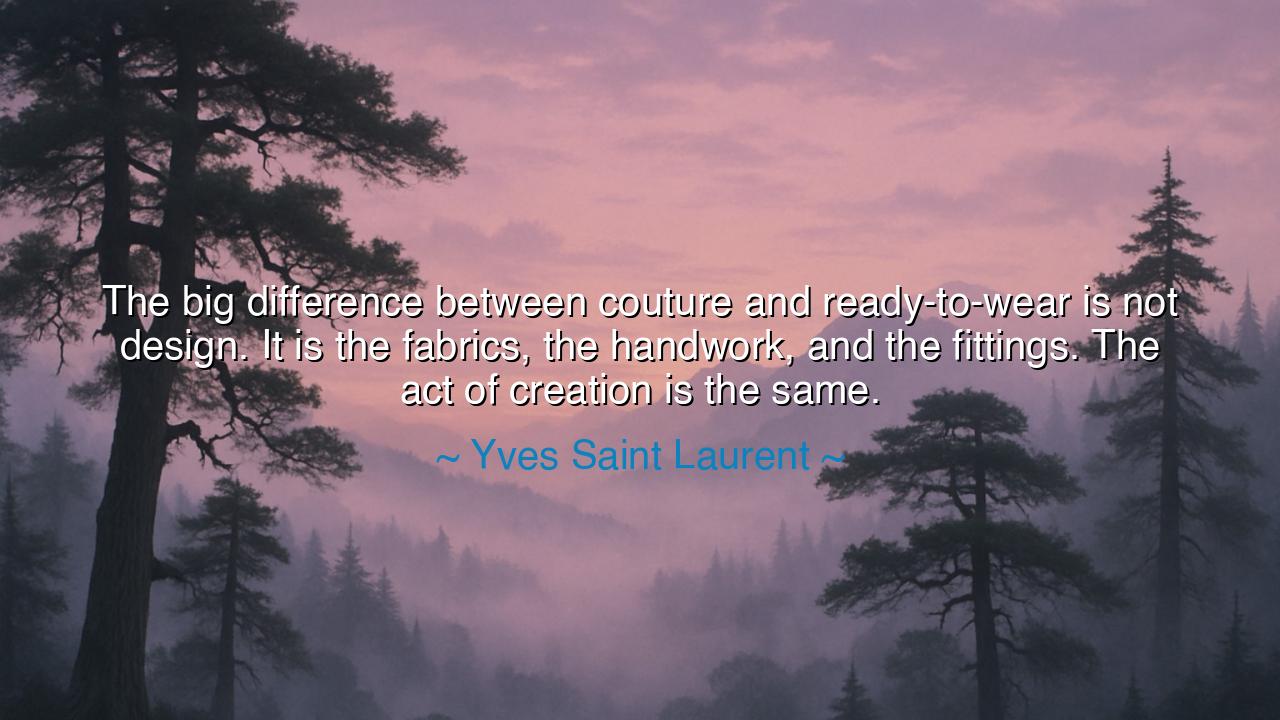
The big difference between couture and ready-to-wear is not
The big difference between couture and ready-to-wear is not design. It is the fabrics, the handwork, and the fittings. The act of creation is the same.






In the luminous world of art and creation, where the boundary between craft and divinity blurs, Yves Saint Laurent, master of form and feeling, once said: “The big difference between couture and ready-to-wear is not design. It is the fabrics, the handwork, and the fittings. The act of creation is the same.” These words, simple yet profound, speak not merely of fashion, but of the eternal nature of creation itself. For Saint Laurent, whether he crafted a gown for royalty or a jacket for the everywoman, the sacred fire that moved his hand was unchanged. He reminds us that creation springs not from circumstance, but from spirit—that the artist’s devotion, not the luxury of materials, defines the art.
To understand the origin of this truth, one must first know the man who spoke it. Yves Saint Laurent was a visionary who redefined fashion’s soul. In his youth, he apprenticed under Christian Dior, inheriting the grandeur of haute couture—the art of garments shaped by hand, fitted to perfection, adorned with the rarest fabrics. Yet Saint Laurent also dared to democratize beauty. In 1966, he launched “Rive Gauche”, his line of ready-to-wear, bringing artistry once reserved for the elite to the streets. Critics wondered: could the hand that stitched couture’s gold also shape garments for the common woman? Saint Laurent’s answer was this quote—a declaration that true artistry does not change when its audience does, for the creator’s heart remains the same.
In these words lies an ancient truth that transcends time and trade. The sculptor who chisels marble and the potter who shapes clay both serve the same muse. The difference is not in their materials, but in the purity of their intent. Saint Laurent’s fabrics and fittings were tools of refinement, but the creative act—the moment when mind, hand, and soul align—was divine and indivisible. Just as a philosopher’s wisdom shines whether written in gold or ink, so too does the designer’s vision shine through silk or cotton. For creation, in its truest sense, is an act of love—and love is no respecter of hierarchy.
Consider the story of Leonardo da Vinci, who painted the Mona Lisa for a private patron but also sketched inventions and machines for the people of Florence. In both, he sought perfection—not because of what he would gain, but because he could not do otherwise. This is the same spirit that moved Saint Laurent. His couture spoke to queens and actresses; his ready-to-wear dressed students and workers. Yet in each, he sought elegance, balance, and truth. His genius lay in seeing that beauty belongs not to the few, but to the many—that the same creative force that shapes the stars also moves in the artisan’s thread.
The ancients would have called this the unity of creation, the belief that all acts of making, great or humble, partake in the divine. The poet who crafts verses on parchment, the mason who builds a temple, the tailor who cuts cloth—all are bound by the same sacred flame. Saint Laurent’s quote is, in essence, a meditation on the dignity of labor and the equality of creation. The difference between the grand and the ordinary lies only in adornment; the spirit of creation itself is one. Thus, when he says, “the act of creation is the same,” he speaks as a sage, reminding us that the soul of the artist does not depend on wealth, but on dedication and vision.
There is, too, a deeper humility in his insight. For Saint Laurent knew that even the most exalted art begins with human hands—hands that cut, stitch, and shape. In acknowledging the fabrics and handwork, he honors the artisans, the seamstresses, and the craftsmen who turn vision into form. This humility connects him to the wisdom of the ancients, who revered the harmony between mind and matter, idea and execution. Just as a philosopher’s thought is incomplete without expression, so too is a designer’s dream without the labor of creation. Saint Laurent reminds us that beauty is born not only from genius, but from devotion—from the harmony between vision and effort.
So let this be the lesson carried forward to every maker, every dreamer, every worker who strives with heart and hand: do not measure the worth of your work by its audience or adornment. Whether you weave for kings or for neighbors, whether you labor in silk or in threadbare cloth, the act of creation is holy if it is done with love. The difference lies not in the splendor of materials, but in the sincerity of your craft. As Saint Laurent teaches, it is not luxury that sanctifies creation—it is passion. Work, then, with integrity and grace, knowing that the divine spark that once moved the great masters burns also in you. For creation is one flame, kindled in many hearts, and every hand that shapes with love becomes a vessel of that eternal light.






AAdministratorAdministrator
Welcome, honored guests. Please leave a comment, we will respond soon